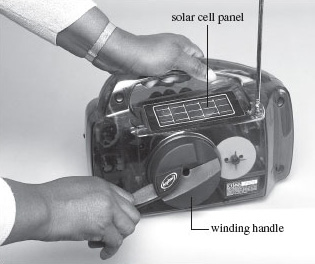1.2 Innovation by context
The word 'innovate' simply means 'make new'. We have chosen in this course to narrow the meaning of this term to be more or less synonymous with 'invention'. I would argue that innovation by context is as much a process as a result. By that, I'm using the term to mean something more like 'creativity'; and it's creativity that lies at the heart of all engineering. More than anything else in our professional lives, we engineers are excited by the prospect of being responsible for the creation of something better than we had before. This does not mean that all engineers are inventors in the sense that the word is normally understood (i.e. taking out patents on some new gadget). Innovation by context is the fruit of the creative process going on in the mind of the engineer when solving a problem, and can be anything from a clever change in the design of a computer program that allows it to run faster or use less memory, to something revolutionary like the jet engine.
For an engineer, creativity is a daily activity. Sometimes, the result is a big enough innovation to call an invention, and to patent, but mostly it's just small but necessary steps in reaching the goal. You can be creative even if your solution is of the type we classify as routine, as we'll show later. There are numerous great examples of innovative solutions, some of which are inventions. How about the first aqueduct, canal, drain, concrete, pilotless aircraft, the building of the Eden Project in Cornwall, the new roof over the British Museum, radar (mapping the skies, speed cameras and predicting weather), the first mobile phone, waterproof fabric, the microwave oven, the compact disk, Dyson's bag-less vacuum cleaner? … the list goes on. It's difficult to pick one example for looking at in more depth, but one of the best and most simple examples of innovation by context has been the transformation of radio into a self-sufficient technology, described in Box 1.
Box 1 Innovation by context – an example
In 1991, inventor Trevor Baylis saw a television programme about AIDS workers in Africa. In poor countries radio broadcasting had always played a part in health education, but in this programme the workers were explaining how batteries were expensive or unavailable and electricity supplies unreliable or simply non-existent. The programme provided Baylis with a problem, and inspired him to find an innovative solution.
Baylis's invention, as you have probably guessed, was the clockwork radio, Figure 2. He wasn't the first person to use springs to generate electricity, but prior to his design the energy had only ever been produced this way for short bursts at a time – here is the context. The innovation is in applying springs to the provision of low-power electricity for consumer electronics. Baylis invented a mechanism that gave forty minutes of play from just twenty seconds of winding. The winding action coils a spring, attached to a gearbox, which is connected to a dynamo. When the spring is released the gearbox controls the steady discharge of energy to produce electricity, and the radio works. The dynamo provides three volts at between 55 and 60 milliwatts, but the design also incorporates a solar-powered source to extend its performance.

Thus power is generated from human input, backed up by free and widely available solar power. Baylis realised that his new technology had huge potential. However, this was only half the task: he also needed to reduce the amount of power consumed by the radio, and this is where the less glamorous and less visible (but at least as important) part of the innovation was done. A team of electrical engineers worked to make improvements in small increments until the power consumption was pared down enough to allow the radio to work for a reasonable amount of time between rewindings of the spring.
Reaction to the radio was initially somewhat sceptical but eventually, in 1994, a prime-time BBC TV programme (Tomorrow's World) agreed to feature the idea. Two entrepreneurs who happened to be watching contacted Baylis immediately, going on to form a company with the intention of putting the clockwork radio into production. 'Freeplay', as they were called, raised a government grant for initial development costs and then found investors, to date selling over three million units. The company has the endorsement of heads of state, international aid organisations, royalty, celebrities, the European Union, the United Nations and more, and has gone on to develop other similar products.
The original problem – that of providing a self-sufficient technology so that radios could be widely available in developing countries – has been solved not only in theory but also in practice, the true test of an innovation.
